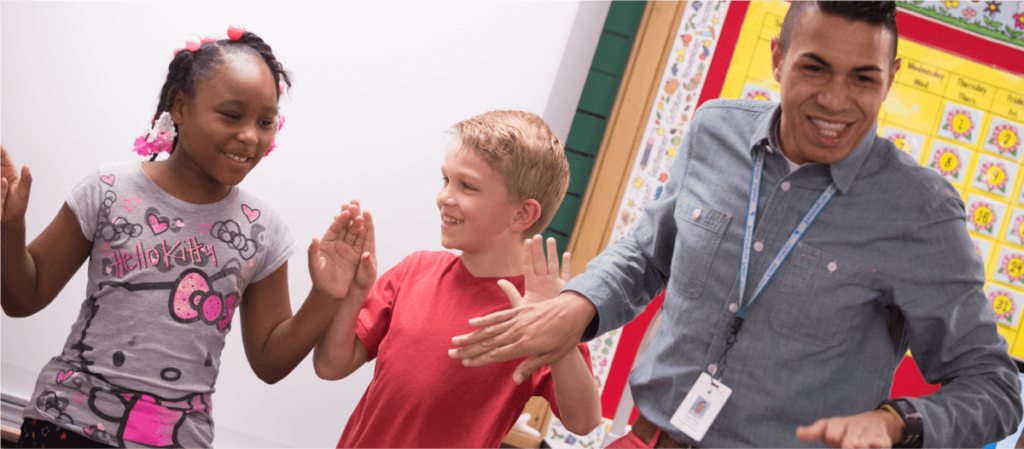
Our class is about to start a collaborative project. Everyone is excited and the room is buzzing with diverse ideas for how to tackle the project. However, this excitement can cause issues: when working in small groups, students can sometimes be too eager and drown out the thoughts and opinions of more passive classmates. Before my students start their group work, how can I empower them to advocate for themselves, validate others’ ideas, and elevate their voices in a respectful and kind manner?
Role-play is a powerful strategy for teaching students to be assertive in a cooperative learning environment because it encourages students to think more critically about a complex situation, gain new perspectives, and gain tools to address similar situations in the future. Here are step-by-step instructions for how you can use role-play to proactively prepare students for successful collaborative work by leveraging the practice’s unique ability to help students both envision and enact a range of positive behaviors.
Think ahead about the language you will use to introduce the goal of the role-play. Make sure to state it in a matter-of-fact way and connect the goal to the rules of your classroom. For example, you might say:
“Sometimes asserting your ideas, opinions, and feelings in a group can be difficult because we are afraid of not being accepted if we have different opinions. Our ideas matter. We want to listen to others’ ideas, and assert our ideas as well, in a way that is kind and respectful, just as our classroom rule says.”
Keep it simple and clear, and direct students to the behavior you want them to exhibit. Prompt students by asking:
“How can I be kind and respectful as I assert my own ideas?”
Support students’ thinking to help them identify what they want or need when working with others. Record all the ideas on a flip chart. Keep it fast paced and redirect any inappropriate ideas. Here is an example of what that could look like:
Mateo’s hand pops up. “We could say, ‘Thanks for sharing your idea. I disagree with that idea, and here is why . . .’” The teacher records his idea on the flip chart.
Sebastian raises his hand. “Say, ‘I respect your opinion, but we are not in agreement.’” The teacher adds the suggestion to the list.
Next, Jane raises her hand with an idea: “You could say, ‘I have a different opinion. I think that . . .’”
By now, the list has three ideas. Students offer more suggestions, and the teacher continues adding to the list.
In advance, plan when and where the role-play will take place. Make sure to determine beforehand the language you will use to start the role-play, such as “Lights, camera, action.” Use this language consistently as you and your students act out the ideas in the list.
While you act out the first idea with another adult or student, set the stage by modeling clearly how to speak up with a firm yet kind tone of voice, and use a strong posture with calm and inviting facial expressions. You can also make clear what idea from the list you are acting out by saying something like, “Hmm, I think I’ll try Sebastian’s idea to assert myself in this situation.”
Use open-ended questions to elicit specific information about what assertive behavior looks, feels, and sounds like. For example:
“What did you notice about the way I asserted myself in that situation? How was this an example of being kind and respectful?”
When students explain things in a negative form, redirect the statement and state it as a question. For example:
“If I did not raise my voice, what did you notice about my tone of voice that made it kind and respectful?”
Go through the list and act out a new idea. Notice where the role-play needs to stop and who will act out that role. You may consider choosing another student or continuing in the lead role. Knowing your students may help you decide who will be the best in that role.
As they act out the scenario, make sure students notice behaviors such as being heard without violating the space of another person.
Engage students in noticing what the actors did to be assertive. This step provides opportunities for critical observation about how it may feel when you use this type of language and how assertive communication builds positive relationships in the community. You may ask again:
“What did you notice about how I listened to my partner’s ideas? What did you notice about my body language?”
If students do not point out the behavior of listening without interrupting, bring that into the conversation and emphasize it.
At this point, assess the energy of your class. If your class seems tired, take a break and come back to the other ideas at a different time.
When the role-play has concluded, summarize how students will use the strategies they have practiced:
“Tomorrow, we will start our collaborative projects, and you will have a chance to use these tools to listen to other ideas and assert your own ideas in a kind and respectful manner.”
As students start working together collaboratively, remind them of the goal. Display the flip chart and read the information together. Remind your students:
“Remember to speak up with a firm and kind tone of voice; calm, inviting facial expressions; and confident posture.”
During the following weeks, display the flip chart in a visible and accessible place. As you hear students using these ideas, reinforce those positive behaviors briefly, privately, and matter-of-factly.
School is all about relationships. How students communicate with each other is crucial. When students communicate assertively and stand up for themselves kindly and respectfully, it ensures positive relationships, increases their self-confidence, and creates a more cohesive classroom community.
For more on role-play, check out Solving Thorny Behavior Problems.
Patricia Cano is a consulting teacher for Center for Responsive Schools.